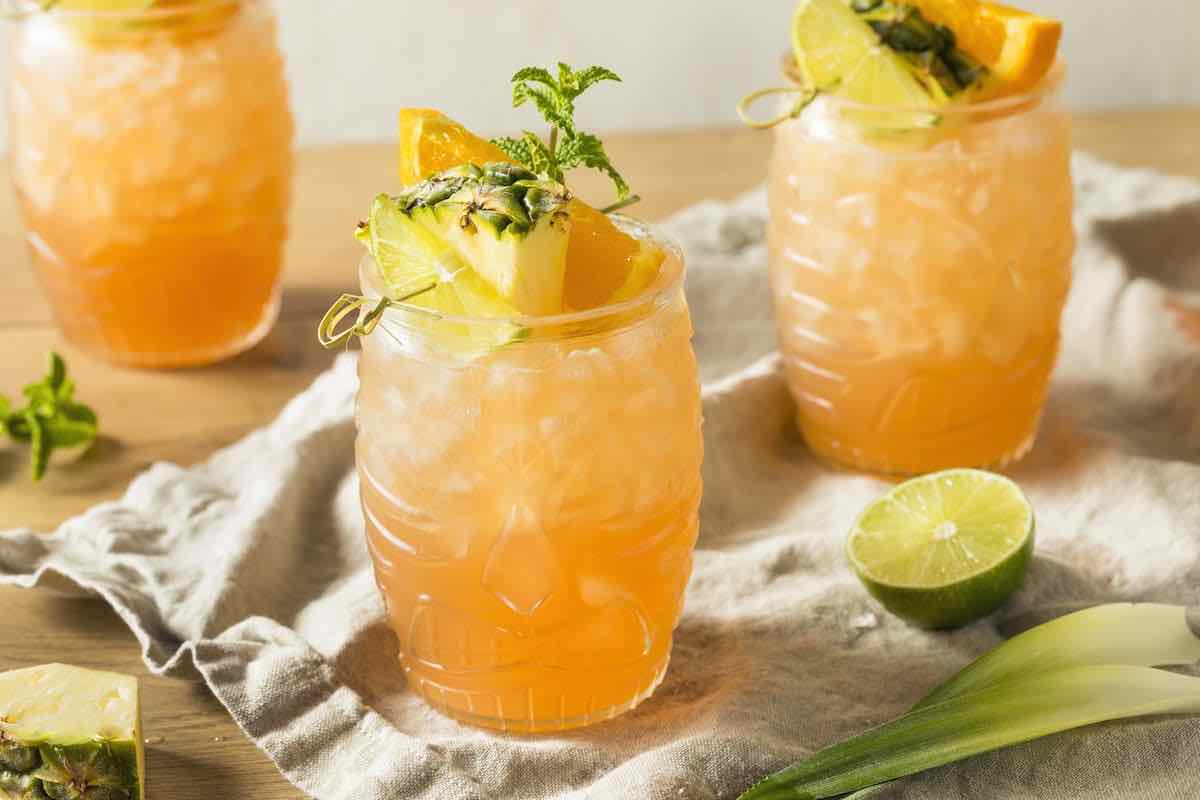When it comes to brown spirits and the Tiki genre, you probably think of rum, rum, and some more rum (and quite possibly all in the same glass). However, the world’s other prominent brown spirit isn’t wholly absent from the annals of Tiki, appearing in a few well-known classics of the genre, including the Suffering Bastard.
However, it still feels like an afterthought, an anomaly to Tiki rather than the rule. There are some fairly obvious reasons for this: It doesn’t fit the imagined-paradise setting and is often thought of (somewhat unfairly) as a cold-weather spirit. But as great fans of both whiskey and Tiki, we decided to comb the genre’s history in search of the spirit and learn how it might be applied to drinking today.
Our first call went out to Brother Cleve, the Boston-based bartender, DJ, and Tiki historian, who listed the practical reasons for why whiskey wasn’t on the scene when Tiki emerged.
“When Don the Beachcomber opened his Hollywood hideaway in January 1934, there was very little whiskey available in America,” Cleve says. “Prohibition had just ended in December 1933, and throughout Prohibition the only whiskeys being made in the U.S. were medicinal (available from your pharmacist) so supplies were very low.”

Adding to whiskey’s woes was the advent of WWII, which saw stills requisitioned for making war materials. The combination of strained supplies and limited production birthed a crop of poor-quality blended whiskeys made with neutral grain spirit. By comparison, rum was cheap, plentiful, and easily imported from the Caribbean, and it fit the tropical stylings of the budding genre.
Whiskey, however, did get a look from fellow Tiki founding father Trader Vic, who had opened his first bar in Oakland the same year. In comparison to Don, who was almost exclusively focused on his “rhum rhapsodies,” Vic made room for other spirits, serving Pisco Sours and gin-based Singapore Slings at his watering hole. Cleve credits Vic for creating the first whiskey-based tropical drink in the early ‘50s, when he conjured the Eastern Sour made with two ounces of bourbon or rye buttressed by orgeat, rock candy syrup, and Vic’s famed sour mix.
Soon after, Stephen Crane of The Luau in Beverly Hills and the Kon-Tiki chain riffed out the Western Sour, which blended bourbon with grapefruit juice, lime juice, sugar syrup and falernum. And in 1965, Trader Vic opened a location in London’s Mayfair Hotel that served the London Sour, which swapped out American whiskey for blended scotch.
Jeff “Beachbum” Berry, a prolific author of Tiki tomes and owner of Beachbum Berry’s Latitude 29 in New Orleans, lists a number of other whiskey-based Tiki drinks that enjoyed mid-century popularity: The Port Light, Starboard Light, Bourbon Special, Rainkiller and Halekulani. He also adds that the inclusion of whiskey was sometimes determined by the drinkers.
“The high-end Tiki restaurant-bars which copied Don’s formula from the 1940s through the 1970s all had Tiki-fied whiskey drinks on their menus to cater to their moneyed, more conservative bourbon and scotch drinking clientele,” Berry says.
Whiskey was sometimes blended with rum as a supporting flavor, as it could add additional depth to a drink with less sweetness. Cleve cites the Tropical Itch served by Harry Yee at his Hawaiian Village Hotel on Waikiki Beach as a classic example of the rum/bourbon combo. The drink, first mixed in the late ‘50s, was a Zombie riff that combined Jamaican rum, overproof Cuban rum and bourbon with passion fruit, nectar and orange curaçao (and came garnished with a wooden backscratcher).

Perhaps the most notable “family” of Tiki drinks to feature whiskey during its heyday would be the “Bastard” cocktails originated by Joe Scialom, which combined a multiple spirit base with lime juice, aromatic bitters and ginger beer. The original iteration, the Suffering Bastard, was originally made with brandy and gin, but the brandy was commonly replaced by bourbon over time. Its two sister drinks—the Dying Bastard and the Dead Bastard—explicitly call for bourbon.
However, the same fad responsible for snuffing out many of the complex, original Tiki cocktails proved even harder on the whiskey-based ones. Starting in the ‘60s, a shift to “blender drinks” with a slushy consistency and syrupy taste left little room for whiskey.
But Tiki’s 21st century revival, which not only resurrected many of the long-lost greats but added new spirits like mezcal and sotol to the mix, has been kind to whiskey as well. Shannon Mustipher’s 2019 book “Tiki: Modern Tropical Cocktails“ features several whiskey-centric recipes.
“Today’s bartenders no longer feel constrained by the orthodoxy of Tiki drinks having to be rum-based and are experimenting with many other spirits,” says Berry. He cites the Polynesian Rhapsody prepared by Scotty Schuder of Paris’s Dirty Dick—which incorporates smoky Laphroaig scotch into its base—as one of his contemporary favorites.
There are, naturally, some whiskeys that perform better in Tiki cocktails than others. Cleve puts high stock in higher-proof expressions, which will better hold their own against the typical plethora of tropical ingredients. As for specific styles, he says that rye is useful for cutting through sweet ingredients, while bourbon’s own corn sweetness can augment dry rums or gins.
More specifically, Cleve suggests bonded bourbons and ryes, including Rittenhouse, Old Overholt Bonded, Old Grandad Bonded and Evan Williams Bonded. Among non-bonded expressions, he’s bullish on Four Roses Small Batch, Angel’s Envy, Buffalo Trace, Pikesville Rye and Sazerac Rye.
Berry, for his part, agrees that higher ABV is better, not just for bourbon and rye but any Irish, scotch, or Japanese bottles you may enlist. And on the subject of scotch, he also suggests playing with something full-bodied and peated.
As our trip down memory lane reveals, the history of whiskey in Tiki is quite rich, and shows plenty of promise for the present-day drinker, too.



